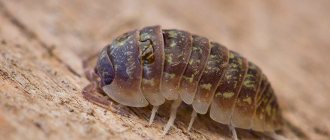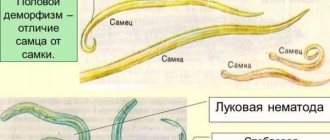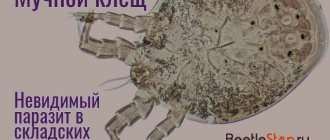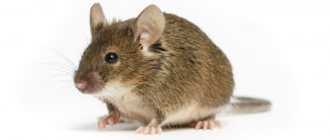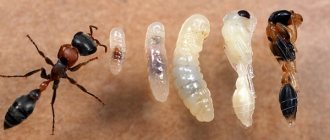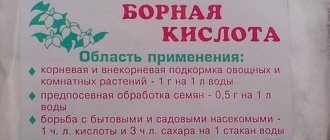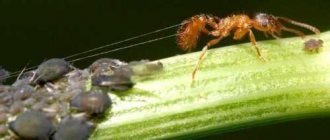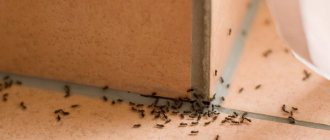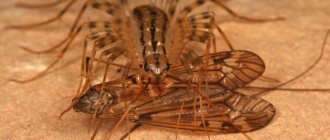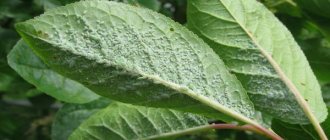The genus Camponotus (carpenter ants) is the largest of the genera that make up the subfamily Formycin. Camponotus has 1000 species of ants, whose life is in one way or another connected with wood. The carpenter ant got its name from the fact that its habitat is trees, in which it makes passages under the anthill. Some woodborers eat wood. In this they are helped by special bacteria that help digest roughage. Another part of this genus uses trees only as a habitat. These woodborers are omnivores, but do not feed on wood, they only make passages in it.
Interesting!
There are 16 species of carpenter ants living in Russia. Three of them are omnivores, love to live in wooden houses and can cause serious problems for home owners. They differ from other species of ants not only in size, but also in their large head with powerful triangular mandibles.
Description of ants
Houses made of wood are environmentally friendly; they are warm in winter and cool in summer. But sometimes uninvited guests move in with the owners. And if rats or mice cause obvious harm, then carpenter ants at first glance may seem harmless. But actually it is not. Typically, representatives of this species live in the forest. They don't bother anyone there. But often these insects build their anthills near their homes. And it doesn’t matter what a person built his house from - brick, clay or concrete. Although most often ants settle and build their nests near wooden structures. They use wood as a building material for their house. A large number of passages made inside the tree make it loose. The ants undermine the lower logs, causing the house to slowly but surely collapse.
The red-breasted carpenter ant is quite large: the body length of males reaches 12 mm, and females are slightly larger - 15 mm. The body color is brown or black, the chest is red. The ant's body is divided into segments. The abdomen is oval, and the chest is thin, cubic in shape with smooth curves at the top. A pair of antennae, antennae and large jaws are visible on the head. Females differ from males in the presence of wings, which they shed after mating. Sometimes males may also have wings. The majority of carpenter ants are workers. They find building material and drag it into the anthill, doing construction work.
Features of the system
The life of lasius niger is to provide the uterus with basic nutrients. Each group of individuals has its own responsibilities:
- breeding offspring;
- anthill protection;
- food production.
The lifespan of females is significantly longer than males. Males die almost immediately after mating. Therefore, the average life of a male lasts no more than a month, and a female lives up to 1 year.
There can only be one queen in one anthill. Sometimes a larger number is possible at an early stage of colony development. Afterwards, the flying females themselves fly out of the anthill, look for places to lay eggs and create their own colony. You can see the differences even by looking at a photo of black ants. Females and males have wings; workers do not have them. The queen initially also has wings, which she later chews off herself.
Big black ants in the garden
Interesting!
Fertilization of the female garden ant occurs during the mating flight.
The larva of this type of ant is a sedentary worm with a whitish color. After reaching the required age, nurse ants help new individuals to be born. They break the egg.
Signs of ants in the house
Carpenter ants leave behind traces of their vital activity - wooden dust, which looks like flour. It is a building material for insect nests. It is easiest to notice early in the morning or evening. It is then that they begin the period of collecting building materials. Dead insects are often found among the dust and sawdust.
Ants move through the developed territory one after another, so they are easy to spot on the floor or near the walls of the house.
By following these hard workers, you can quickly determine their favorite place. Proof that carpenter ants have settled near the house are rather large white eggs hidden in the nesting box. If the rot is located next to a wooden building, carefully inspect the walls of the house and pierce the walls with a thin screwdriver. This will help detect passages inside the tree.
Sometimes woodworms build an entire colony in the vicinity of a house. In this case, they lay paths between individual nests. Sometimes they can pass through the territory of the house. They easily penetrate there through microscopic cracks.
Types of insects
Black ants are numerous. The following species are most often found in a person’s garden or home:
- Garden or common (Lasius niger). Its body has a length of 4 to 11 mm. The buildings of this type of ant are especially noticeable in the spring, when the grass is short - there are earthen mounds everywhere. Insects have become comfortable in the city - they build nests underground and crawl out into the sun from cracks in the asphalt. They are most dangerous for the garden because they specifically grow aphids, care for them, and protect their droppings. Farmer ants milk pets and eat their milk, while aphids suck juices from plants.
- Scented Wood (Lasius fuliginosus). The insects are no different in size from an ordinary ant. On the street they settle in a rotten trunk or in the hollow of a tree, and in people's homes they settle in the walls of houses, around pipes and thermal communications. They build their nest from a material resembling cardboard - a mixture of chewed wood and saliva. The odorous ant got its name from the peculiar smell that it emits when it detects food, as well as when it is in danger or needs help.
- Woodworm (Camponotus). Camponotus lives all over the world - in taiga, mixed forests, deserts and semi-deserts. It got its name because of its ability to gnaw holes in (usually dead) wood. It is in danger of extinction, which is why this species of ant is listed in the Red Book. Its length reaches 15 mm. Insects help the forest - they clean it and loosen the soil. However, for wooden houses they become a serious problem: they gnaw holes in the wood, the logs gradually deteriorate, crumble, and the house loses its strength.
- Turf (Tetramorium caespitum). Such insects live in places covered with turf. They are not found only in the Far North. They are able to use cavities underground without external structures, in rotten wood and in the subcrust of rotten stumps for nests. When they get into people's houses, they crawl through the cracks and wander from one room to another. Local elimination of turf ants is almost impossible, since their nests are not clearly visible.
- Black Crazy (Paratrechina longicornis). Individuals of this species move in an incomprehensible order, chaotically. They are located at the bottom of the food chain, but at the same time they manage to annoy other species of living beings, including humans. The bite of a crazy ant causes severe irritation, and these parasites also chew on wires, which damages equipment and equipment.
Where to look for ants
- Woodworms settle in damp wood because it becomes soft when exposed to water. It is much easier to make holes in such material. Therefore, they are investigating the places where the sewer exits.
- Check existing door mats.
- They inspect the foundation and courtyards.
- They look for woodworms in the grass, lawns, and under bushes.
- Explore the area around young trees. It is usually covered with a thick layer of damp mulch or leaves in which ants like to live. To find them, rake the mulch and inspect the ground.
- Woodworms can live in compost heaps. Sometimes they settle in floors and in potted plants.
Care requirements
- Feeding – All woodworms require regular feeding of syrup, and almost all require feeding of fresh insects.
- Formicarium - most woodworm species start in the soil, and only as the colony grows does it settle in the tree. Therefore, as the first formicarium, it is worth using formicariums with moisture (there are exceptions).
- Humidity gradient – cocoon maturation does not require high humidity, so local humidification will be beneficial.
- Lighting – A heating lamp combined with a shelter in the arena creates a nice solarium for the ants to warm their cocoons.
- Wintering - all woodworms in the middle zone are recommended to winter - otherwise the colony may die. Read more about wintering in our article - “Wintering with ants”
How to prevent ants
There is no need to wait for ants to appear in the house. Every possible measure should be taken to prevent them from appearing.
For this purpose, branches that bend close to the windows are cut off. All flowers, vegetables and fruits are inspected and shaken off so as not to bring insects into the house. You cannot leave heaps of garbage, branches, or last year’s leaves on the site. They can become a haven for carpenter ants.
The inside of the house must be kept clean, the floors washed frequently, and the trash can covered. You cannot leave unwashed dishes. Windows should be covered with nets; doors should not be left open.
If there are ant heaps nearby the site, the danger of them moving into the house increases. To scare away uninvited guests, you can scatter substances with a pungent odor. These are essential oils, pepper, turmeric, cinnamon.
Nomadic
This type of ant is called nomadic because of the lifestyle of its representatives. Insects do not have their own nest; they constantly travel, stopping only for a while to replenish their population. Then, from their own bodies, they construct temporary housing that resembles a large lump. In its center the queen lays eggs. With the advent of young offspring, the ant family “lifts anchor” and goes in search of another feeding territory.
Nomads are relatively large individuals (their body length reaches up to 15 mm), which is why they often find themselves in the ranking of the largest ants in the world. What catches your eye is the frightening-looking jaws of the insect, the size of which even exceeds the dimensions of the head. The female is larger than the male; during the period of laying eggs, her body size can reach up to 5 cm. Photos of nomads can be seen below.
Nomads are ants
The insects are found in Africa, Central and South Asia, and North and South America. They are called killer ants because the nomads destroy all living creatures they come across on their way. These can be not only small insects; representatives of this species are able to feed even on small rodents and reptiles.
How to find a nest
How to get rid of carpenter ants? First you need to find their nest. To do this, you need to monitor the movement of insects along the paths they have designated. They will show traces of dust carried by large black ants. The woodworm lives in damp trees, lying posts, and boards, leaving noticeable winding passages on them. Near the nest, the amount of dust increases significantly.
You can also look for places on the tree where the wood is most damp. This is where carpenter ants like to place their nests. How to get rid of them?
What harm does an ant cause?
Such small pests can cause very big troubles in your summer cottage. Reproducing exponentially, black ants seek food for their offspring by eating a lot of plants. Most of all, ants like to feast on strawberries, currants, potatoes, carrots and other cultivated plants. Having settled in your garden plot, ants will cause great harm:
- feeding on the sap of cultivated plants and trees, garden ants gnaw the protective cover, which can cause fungal bacteria to infect the plant and cause it to begin to hurt;
- gnawing on the roots of a tree, they like to make their own colonies there;
- in the garden they often eat seeds and plants;
- a great love for sweets leads to eating red berries and fruits;
- digging their new nests on the ground, they cover the sprouts with earth;
- at the place where they are located, the acidity of the soil changes, which harms the growth of plantings;
- garden ants are specially bred and feed on aphids; without aphids, the ants are doomed to starvation;
- By breaking through tunnels, they spoil the flower bed, lawn and beds of earthen land.
How to deal with woodworms
There are several ways to control woodworms. Which one to choose depends on several conditions.
Chemical and natural insect repellents can be used. It is better to use organic folk remedies near home. Especially if there are children and animals there. But in some cases, chemicals have to be used in inaccessible places.
You can do something radical and destroy the ant nest. If you do this soon after they move in, they will leave. But they can move to another place or settle into several colonies, creating new problems.
Special baits are very helpful in the fight against ants. Their action is prolonged and more reliable.
You need to be careful not to get ants on your hands. In a calm state, they do not harm humans. But if the nest is attacked, they begin to bite painfully. The burning sensation is further enhanced by the fact that they inject formic acid into the wound.
Worker ants
This is the largest group of inhabitants of the anthill. The first ones to appear after the queen lays the first chamber of the future anthill are the builder ants. He expands and strengthens the future underground kingdom, takes care of future offspring.
Worker ants are divided into several subgroups within their group. Who performs what duties depends on the individual qualities of each insect. For example, individuals with proactive inclinations and reactions become hunters or scouts. The more sedate ones graze and spread aphids to plants and collect their sweet honeydew. The change in activity can only be influenced by age, when the old ant is no longer suitable for reconnaissance or hunting, or the sudden death of most of the colony.
Young specimens work underground, inside an anthill. They build new cells, dig passages, and care for larvae and females.
They say about some people: “Works like an ant.” And it does not mean that the result of his work is microscopic. On the contrary, it is praise denoting a gigantic job done alone. The comparison with insects is not accidental. Few in the animal world can boast of such strength and endurance. The little ant is able to lift and carry weight 50 times its own!
And if several insects join forces, the number increases to 70-80! This is because the ant's body structure is dominated by muscle tissue. Considering the size of the anthill and the number of “freeloaders” that the worker ant provides with food, it is clear that it is not at all superfluous in strength. A stubborn insect, if unable to lift and carry large prey, will drag it along the ground behind it until help arrives.
Surprisingly, when an obstacle appears on the way, the ants cling with their paws and form living bridges up to several meters long. This is usually necessary to overcome a stream, a crevice, or any place where it is not possible to walk on the ground. So, such a bridge can withstand a load of several kg.
Mechanism of action of toxic bait
If it is difficult to get to the nest, toxic baits are installed near the insects’ home. It’s a good idea to mix their contents with sweet foods. The ants, having discovered the “treat”, try it themselves and bring it into the anthill. There they infect their brothers, as a result of which they die. Three days pass from infection to death.
Nowadays, gel baits are popular, for example “Anteater”, “Clean House”, “Great Warrior”. They are mixed with jam or sprinkled with sugar. 3 baits are placed near one nest. It is better to choose those that act slowly. Then the ant will probably have time to get into the anthill and transfer the poison.
Gel baits are very effective. They help get rid of insects forever. Treatment with chemicals should be carried out in a respirator, making sure that they do not get on the skin of the hands and face, or into the respiratory tract. After handling, wash your hands thoroughly with soap.
Information about character and lifestyle
Paraponera clavata is characterized by a very developed social structure. Such an ant throughout his life does what he is supposed to do in the family. The colony includes builders, breadwinners, and a female responsible for procreation. They are most often active at night, since at this time they get food. The main principles of the colony are peace and mutual assistance.
But it is worth noting that they do not like their relatives from other families, and clashes and clan enmity often arise. Arthropods dig a deep hole in order for a large family to settle there. Caring for offspring is the responsibility of males and females. The adult, which is responsible for the food production process, brings food products for the larvae, as well as the queen (they almost never leave the nest).
The foraging process is carried out on trees or forest floors, and working individuals can leave the anthill at a distance of more than 40 meters. They develop a special strategy for searching for food, during which each is responsible for completing a specific mission. When returning home, 40 percent of the group brings liquid, 20 percent brings dead pests, and the rest are responsible for vegetation.
Ants that bring cargo have a higher speed of movement than individuals without cargo. If there is a food source close to the nest, they choose it exclusively. It should be noted that the nest is guarded by special guards - groups of several individuals. If an incomprehensible situation arises, they begin to survey the area, and if a dangerous moment arises, the entrance and exit are closed, as well as a warning to other relatives about the onset of danger.
Speaking about the attitude of Bullets towards humans or other creatures, they will not become aggressive until they feel danger. If you approach their home or try to catch it, they will first begin to warn by hissing and secreting a bad-smelling liquid, thereby indicating danger.
Then they insert a sting and release a paralytic poison. Allergy sufferers may face particular harm, and the bite can be fatal.
Fight with sprayers
The nest, which is easy to get to, can be destroyed using sprays. A special powder is placed in them - a remedy for carpenter ants. Stores that specialize in means of protection against various pests have a wide selection of such drugs. You can use ready-made sprays: “Dichlorvos”, “Regenta”, “Raptor”. Direct the stream towards the nest. The treatment is carried out several times. It is better to do this in the evening, when all the ants have returned home.
Do not spray paths along which insects move. The drug will scare away the worker ants, who will soon build another path for themselves, and the queen will remain and continue to reproduce.
Remember: such products are highly toxic. Therefore, when using them to combat carpenter ants in the house, you must follow the instructions for using the drug. Do not spray sprays in areas where children or pets can reach.
Chemicals must be used in a respirator and protective suit. Hands are protected with gloves.
Behavior
The garden black ant is a non-aggressive creature, but endowed with a sting with poison. They use their weapons during hunting, when enemies attack, or when danger approaches. The insects bite quite hard, leaving an inflamed red mark. For a person prone to allergies, an ant bite can cause serious health problems.
Interesting!
There are always several adults guarding order. In case of danger, they give a signal to the others and attack the enemy en masse. In an instant, a whole colony of insects appears on the foot of a person who steps next to an anthill.
An insect will not just bite. He will crawl freely along his arm and leg if he is not in danger. The slightest pressure on the body leads to a defensive reaction.
On a note!
In nature, there are a huge number of giant black ants that can bite domestic animals to death and cause significant damage to human health. This type of ant lives in tropical countries. When insects infest, residents leave the house, taking their entire household with them.
Use of boric acid
Boric acid is used to combat various insects, including carpenter ants. To do this, mix it with sugar in a 2:1 ratio. The resulting mixture is laid out in small dishes and placed around the nest. Ants go for sugar, and boric acid enters the body with it. It dissolves the insect from the inside. Working individuals bring boric acid into the nest. This way it will get to the females and other inhabitants, destroying them.
Nutrition
Large black ants in the garden find food for themselves, their larvae. Adults feed on plant juices, a sweet secretion secreted by aphids. To obtain food, ants spread aphids throughout the garden, providing them with the most succulent trees in the country. Behind it they collect honey dew.
Ants' habitat
Interesting!
Black ants keep aphids in their home in a special chamber. They provide her with adequate nutrition, tickle her with antennae, and receive a sweet delicacy.
The larvae are more voracious. They need protein foods. Adults bring them insects, worms, and slugs. These feeding habits make black garden ants useful and harmful. Insects will destroy small pests and spread aphids themselves, causing significant damage to crops.
Folk methods of struggle
If chemical methods cannot be used, they try to use folk remedies:
- Fill the nest with boiling water or vinegar. In this case, a significant part of the ants die.
- Use garlic arrows (put them in an anthill). Insects are afraid of this strong smell.
- A dish with sugar syrup bait is placed near the anthill. Ants crawl into it to feed and drown there.
- They mix yeast with water and sugar or coffee grounds, which kill insects.
- Prepare black soap by mixing 400 g of laundry soap, 200 g of kerosene and carboxylic acid (2 tbsp). Dilute with warm water and fill the anthill. Repeat after 2 days 3 times.
- To destroy an anthill, this method is only suitable if it is located away from home. Fill it with kerosene and set it on fire.
You can use one or more different methods to get rid of carpenter ants.
Remedies for carpenter ants: review of 10 products
The package for ~$3.34 contains four stations with baits. They are used indoors. The product works for three months and is replaced with a new one if necessary. The manufacturer guarantees a money back if the product turns out to be ineffective. There are quite a few negative reviews on Amazon.
A 30 ml tube of gel turned out to be one of the most popular products. It costs ~$26.64 and has a shelf life of two years. The gel is designed to combat many types of ants in the house. Amazon users gave it over 80% of the highest ratings. To use, a small amount of bait is squeezed into a crack or other hard-to-reach place near the anthill.
The product is sold in a pack of six stations with baits for ~$6.08. The station is installed in the ground or on the surface. The principle of operation is the same: transfer the poison to the worker ant so that it does the same in the anthill. Buyers praise the bait. It can be purchased in strips and in small stations of eight for ~$6.17.
The insecticide contains bifenthrin and sells for ~$14.05 in a 5-liter canister. It is sprayed onto a dry surface, after which it is not removed for 24 hours. The product is lethal to insects and creates a barrier that protects the area in the house for up to a year, and outside for up to three months.
A bottle of spray costs ~$8.97, but a concentrate is also sold. The spray kills many types of insects, including ants. As buyers write on Amazon, the product does not affect all types of ants, but woodworms are not mentioned among them. Can only be used outdoors.
A professional insecticide containing 4.75% deltamethrin costs ~$41.42. The product is diluted in a large amount of water, and it is enough to spray it over a large area indoors or outdoors. The spray leaves no odor and is rated positively on Amazon.
Talstar spray contains bifenthrin and is suitable for fighting ants. Sold in concentrated form for ~$41.65. It is mixed with water and sprayed. Validity period is up to three months, provided that it is used correctly on a dry surface.
Attention: the insecticide is toxic to aquatic animals and plants and should not be used near bodies of water. Avoid contact with skin (use gloves) and mucous membranes. Wait for the treated surfaces to dry, then they will become safe.
Diatomaceous earth is a universal non-toxic remedy for insects and arachnids. The remaining diatoms are crushed to a specific size where they become sharp weapons against insects. The edges of diatomaceous earth particles cut the chitinous cover of the insect and damage it. The product will help get rid of the carpenter ant. It is safe for people and animals and cannot harm the skin. Sold in a 1.8 kg bag. Cost ~$14.47. Sprinkle this flour on the places where ants accumulate and migrate into the house.
Another traditional remedy is boric acid. A 450 gram tube sells for ~$6.99. Acid was previously used as an antiseptic, after which it was replaced by stronger antiseptics. Boric acid is also used in the fight against ants. The powder is placed in the cracks, behind the baseboards, and sprayed through the entrances to the anthill.
Clove oil is not an insecticide, but is also used to repel insects. To do this, it is diluted with a large amount of water. Warning: essential oils are dangerous for pets, especially cats, pregnant women and small children. Should not be used in its pure form.
Mushroom grows from an ant
“The fungus - cordyceps unilateralis (Ophiocordyceps unilateralis) - infects the nervous system of the ant, turning the hardworking soldier into an asocial zombie: the infected insect leaves the colony, descends from the tree to the ground and attaches itself to some leaf, digging its mandibles (mandibles) into the vein of the plant. Having grabbed the leaf with its mandibles, the zombie ant dies. After some time, the fruiting body of the very fungus whose spores turned it into a zombie grows out of the insect’s head,” writes David Hughes in a new article on the death walks of sick ants.
Scientists explain that while the insect corpse hangs upside down, at a height of about twenty-five centimeters, the sprouted mushroom ripens and begins to “burst at the seams”: spores scatter on the forest floor and other ants. That is, the pathogenic fungus does not just grow in the heads of insects: brain mold uses its host to develop and spread. “An ant hovering above the ground is an ideal environment for the reproduction and development of a fungus,” scientists explain. “The humidity here is high (up to 95%) and there are enough nutrients.”
Reproduction
Most of the ant family consists of females incapable of fertilization. They are divided into several clans, perform construction work, obtain food, ensure the safety of the anthill, care for the queen, and feed the larvae.
A small proportion are young males and females. Once a year, during the warm season, they begin to mate. Woodworms grow wings, flying ants rise into the air and mate there. After a successful process, the males die, the females look for a place for a new anthill and lay eggs there.
The queen is responsible for raising, feeding, and raising the first cubs herself. Forms them into working carpenter ants - builders. The insects begin building a nest, and the female lays the next batch of eggs.
The reproduction process is endless; the colony of carpenter ants is replenished with new members of the society every week. Gradually, the responsibilities for caring for the larvae, feeding, and maintaining the queen are transferred to working ants - midwives, nannies, and nurses. The queen only lays eggs.
First steps to success
When you see ants, you should not stomp your foot, crush them with your fingers, lay out sticky traps, there is no point in this. Insects that crawl in search of food are worker ants that do not have the ability to lay eggs or continue their race. The main target is the queen, located in the nest, anthill. This is what you should look for.
If there are ants in a wooden house, you need to treat them with sweets and watch where they take them. These are not measures of hospitality, but ways to find out where the nest is.
The ants will move towards the home along the studied route. Having noticed their trajectory, you can explore the area. The main symptoms are the presence of rot and holes in the logs. Ants place nests between beams, in walls, insulation, wooden furniture, doors, and under baseboards.
If you manage to find an anthill, it will be much easier to fight the ants. A destroyed nest serves as the basis for the relocation of all residents to more favorable places.
